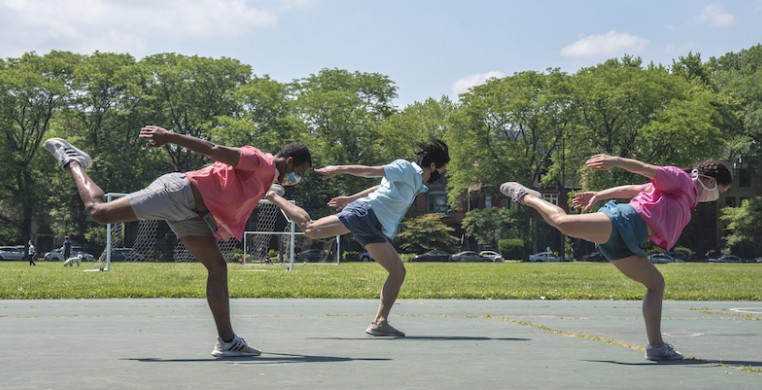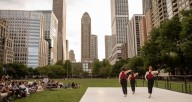In the shift to virtual dance, many artists look to engage audiences with talk of the innovation and creativity that’s gone into this alternate way of viewing performance. But for Dance in the Parks director Katie McCann, the need for virtual performances is much simpler. At the root of her efforts to move the 2020 Dance in the Parks season online—a season performed any other year outdoors in public parks—is the plain fact that it’s her job to facilitate dance. It’s her job to perform and to use art to comment on the world around us.
For this year’s Dance in the Parks, McCann worked with longtime partners the Chicago Park District and Night Out In The Parks to facilitate the creation of dance films surrounding themes of the pandemic and stay-at-home orders. Ashley Deran and Emily Loar (collaborating together), Joe Musiel, Jackie Nowicki, Fernando Rodriguez, Michel Rodríguez Cintra and Sarita Smith-Childs all created and rehearsed choreography over Zoom. They then were paired with professional videographers to film in various parks around Chicago (where the dancers could keep safe distance from each other while dancing) and to edit the films. Filming took place within the dancers’ homes (via phone or laptop cameras) and in Calumet Park, Kenwood Community Park, Ping Tom Memorial Park and the Garfield Park Conservatory.
Half of the films will premiere July 31 and the other half Aug 1 on the Dance in the Parks Facebook Live and IGTV. The films will then be posted to the Dance in the Parks website following the social media premiere. Each night will be short and sweet, with about 20 minutes of total viewing time.
Dance in the Parks’ mission is to bring free, professional dance concerts to a variety of public parks across the city, with the goal of connecting new audiences to dance. In a usual season, the dance company gives out free tickets to other performances in the city and highlights the work of youth dancers at studios and programs close to the parks that they perform in that evening. With the cancellation of much of their summer programming, McCann feels it is only fitting that Dance in the Parks uses these six dance films to sympathize with viewers and present multiple perspectives of understanding the world in this moment.
“We’re dancers. We dance. This is what we have to do. Making and performing dance is how we work through what’s going on right now, and it’s also our job. We want audiences to know that we are in this with you together: the same way that you are stuck in your house, I am also stuck in my house. I just happen to be dancing on my couch,” McCann said in a phone interview. “When does that happen that you can address a global moment through art that literally no one can ignore?”
Each film looked at this global moment differently, from the geometric grid with points 10-feet apart that inspired Ashley Deran and Emily Loar to the reflective state that influenced Smith-Childs. Looking to encourage audiences to empathize with those directly affected by the coronavirus pandemic, Rodriguez created a dramatic love ballad between a couple separated after one partner becomes chronically ill and is hospitalized. Musiel took an opposite approach and created a light-hearted film that turns to childhood memories of superheroes and escape from the real world.
The collaboration between the choreographer and videographer has been integral to crafting these separate worlds of each film, as well as providing an opportunity for the choreographers to expand their creative practices.
“Thinking about creating on film, it’s fun and challenging but it also makes you problem solve. The possibilities are endless. So, my piece was constantly evolving as I was creating it and evolving through when we were shooting,” Rodriguez said. “The biggest thing I’ve taken away is to not get comfortable in a studio or a stage setting, but to get creative with ideas as though the performance weren’t going to be onstage—even if it is going to be onstage. I think that can take choreography to a whole new level because it breaks your typical formula or process that works for you.”
In light of the abundance of virtual dance programming happening right now, McCann urges audiences to check out the Dance in the Parks live stream, if not for the dancing, for the opportunity to experience parks across the city in a new way. At the core of these films is an opportunity for viewers to confront the global pandemic in a new way, while potentially finding emotional relief as well.
“I’m hoping audience members will be able to have five minutes where they’re able to smile and laugh and not think about being shut indoors or think of how they may be incapacitated with certain things they used to be able to do,” Mussiel said. “To have a few minutes where they think outside the box for a little bit and experience something new and different.”
--
The virtual Dance in the Parks performance premieres July 31 and Aug 1 on Dance in the Parks Facebook Live and IGTV. The films will then be posted to the Dance in the Parks website following the social media premiere.
Discloser: Emily Loar is a freelance program coordinator for See Chicago Dance.


